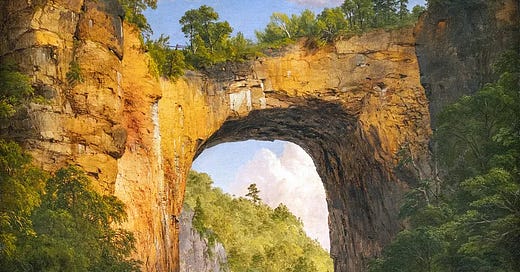Jefferson's Arch and Frederic Church
FOR JEFFERSON, IT SYMBOLIZED SOMETHING ABOUT THE NAISCANT REPUBLIC
Frederic Edwin Church, The Natural Bridge, Virginia, 1852, oil on canvas, 28 x 23 in., The Fralin Museum of Art at the University of Virginia, Gift of Thomas Fortune Ryan.
“In 1836, in his book-length essay “Nature”, Ralph Waldo Emerson instructs Americans — artists, poets, novelists, politicians — to use American nature in metaphors that address the idea of the American nation.” – Tyler Green
Thomas Jefferson owned the marvelous arch, which the native Monacans [click to read] had named Mohomony — The “Bridge of God.” To the Monacans the bridge already symbolized the survival and struggle of their own nation. Now Jefferson saw it as symbolic of the struggle and survival of the young United States.
He wanted John Trumbull, the painter who had immortalized the great battles of the American Revolution, to paint the bridge. He asked Trumbull to travel there and paint it firsthand, charging him to “take to yourself and your country the honor of presenting to the world this singular landscape, which otherwise some bungling European will misrepresent.”
Frederic Edwin Church would visit the bridge much later, and where many artists had presented it in a horizontal composition, Church chose to emphasize its verticality. His painting certainly captures the rugged nature of the bridge, and it is extremely accurate (compare it with my photos of the present day bridge in tomorrow’s article).
Two figures appear in the painting — a woman and a man. Someone told me the man was the caretaker. Is Church, in his tumultuous times, using the man’s gesture to point to that story of struggle and survival for the young republic?






Personally, I think the people were added to provide scale. :-)